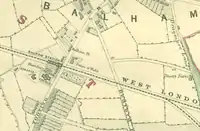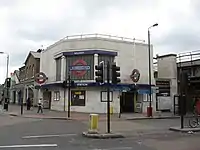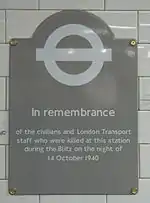Balham station
Balham is an interchange station formed of a range of underground entrances for the London Underground ('tube') and a shared entrance with its National Rail station component. The station is in central Balham in the London Borough of Wandsworth, south London, England. The tube can be accessed on each side of the Balham High Road (A24); National Rail on the south side of the road leading east, where the track is on a mixture of light-brick high viaduct and earth embankment, quadruple track and on a brief east–west axis.
| Balham | |
|---|---|
 Balham station east building including shared entrance | |
 Balham Location of Balham in Greater London | |
| Location | Balham |
| Local authority | London Borough of Wandsworth |
| Managed by | Southern London Underground |
| Owner | Network Rail London Underground |
| Station code | BAL |
| DfT category | C2 |
| Number of platforms | 4 (National Rail) 2 (Underground) |
| Fare zone | 3 |
| London Underground annual entry and exit | |
| 2015 | |
| 2016 | |
| 2017 | |
| 2018 | |
| 2019 | |
| National Rail annual entry and exit | |
| 2015–16 | |
| – interchange | |
| 2016–17 | |
| – interchange | |
| 2017–18 | |
| – interchange | |
| 2018–19 | |
| – interchange | |
| 2019–20 | |
| – interchange | |
| Railway companies | |
| Original company | London, Brighton and South Coast Railway (National Rail) City and South London Railway (London Underground) |
| Pre-grouping | London, Brighton and South Coast Railway |
| Post-grouping | Southern Railway |
| Key dates | |
| 1 December 1856 | first station opened as Balham Hill |
| 1863 | present station opened (LB&SCR) |
| 6 December 1926 | Opened (C&SLR) |
| 14 October 1940 | Closed for repairs (Underground) |
| 12 January 1941 | Reopened (Underground) |
| Listed status | |
| Listing grade | II (Underground station) |
| Entry number | 1225887[5] |
| Added to list | 16 June 1987 |
| Other information | |
| External links | |
| WGS84 | 51.4432°N 0.1525°W |
On the National Rail network it is 4 miles 52 chains (7.5 km) from London Victoria.
It is in Travelcard Zone 3. The conjoined stations are owned and operated separately with different ticket machines and gatelines.
National Rail station

The National Rail station is on the Brighton main line, four stops from London Victoria. On a north–south route, the tracks pass through Balham on an approximate east–west axis, with Victoria towards the west. The station is managed by Southern. The platforms are on embankment between bridges over Balham High Road and Bedford Hill. Access to the platforms is via an underpass beneath them. There are four tracks and four platforms.[6] The station is between Wandsworth Common and either Streatham Hill, Streatham Common or Mitcham Eastfields.
History
The West End of London and Crystal Palace Railway opened a station named Balham Hill on 1 December 1856,[7] at which time the line ran between Crystal Palace and Wandsworth Common. From the outset the line was worked by the London, Brighton and South Coast Railway, which purchased the line in 1859 after it had been extended to Pimlico.


The original station was on the west side of Balham High Road; it was re-sited by the LB&SCR in 1863 as part of works to widen the line, and improve the route between East Croydon and Victoria.[8] Further remodelling of the line was undertaken in 1890 and 1897 to increase capacity.[9] It was named Balham then renamed Balham and Upper Tooting on 9 March 1927, reverting to Balham on 6 October 1969.[7]
The lines through the station to Crystal Palace were electrified in 1911,[10] by means of the LB&SCR 'Elevated Electric' overhead system. Work on electrifying the remaining services through the station had begun in 1913 but was interrupted by the First World War and not completed until 1925.[11] By this time the LB&SCR had been absorbed into the Southern Railway following the 1921 Railways Act. In 1925 the Southern Railway decided to adopt a third rail electrification system and the lines through the station were converted between June 1928 and September 1929.[12]
When sectorisation was introduced in the 1980s, the national rail lines were served by Network SouthEast until the privatisation of the British Railways in the 1990s to the Connex South Central franchise, replaced by the current operator in 2000.
.jpg.webp)
The station has a high brick wall along Balham Station Road on which are four cold cast bronze reliefs, "Impressions of Balham". These depict local residents and everyday scenes. They were conceived and constructed by Christine Thomas and Julia Barton and installed in 1991 by Wandsworth Borough Council.
London Underground station
The station opened on 6 December 1926 as part of the Morden extension of the City and South London Railway south from Clapham Common. The line and other stations on the extension had opened earlier, on 13 September 1926.[13] The station is between Clapham South and Tooting Bec stations.


Along with the other stations on the Morden extension, the building was designed by architect Charles Holden. They were Holden's first major project for the Underground.[14] He was selected by Frank Pick, general manager of the Underground Electric Railways Company of London (UERL), to design the stations after he was dissatisfied with designs produced by the UERL's own architect, Stanley Heaps.[15] The Underground station buildings are listed Grade II.[5]
The station has entrances on the east and west sides of Balham High Road linked by a pedestrian subway. The modernist designs of each building take the form of double-height screens clad in white Portland stone with three-part glazed screens in the centres of the façades divided by columns of which the capitals are three-dimensional versions of the Underground roundel. The central panel of the screens contain a large version of the roundel. Balham is the only station on the Morden branch of the Northern Line conjoined to a National Rail station.
Second World War
During the Second World War, Balham was one of many deep tube stations designated for use as a civilian air raid shelter. On the evening of 14 October 1940, a 1400 kg semi-armour piercing fragmentation bomb fell on the road above the northern end of the platform tunnels,[16][17] creating a large crater into which an out of service bus then crashed. The northbound platform tunnel partially collapsed and was filled with earth and water from the fractured water mains and sewers above, which also flowed through the cross-passages into the southbound platform tunnel, with the flooding and debris reaching to within 100 yards (91 m) of Clapham South. According to the Commonwealth War Graves Commission (CWGC), sixty-six people in the station were killed[18] – although some sources report 64 shelterers and 4 railway staff were killed[19] and more than seventy injured. The damage at track level closed the line to traffic between Tooting Bec and Clapham Common, but was quickly repaired, with the closed section and station being reopened on 12 January 1941.[20]


In October 2000 a memorial plaque commemorating this event was placed in the station's ticket hall. It stated that 64 lives were lost, which differed from the CWGC register at the time, and other sources. On 14 October 2010 this was replaced with a new commemorative plaque which does not state the number of fatalities.[21] This second plaque was again replaced with an official memorial stone in Welsh slate commissioned by London Underground and that was unveiled on 14 October 2016.[22] The second removed plaque was again deposited with the London Transport Museum.
The bombing of the station during the war is briefly mentioned in Ian McEwan's novel Atonement, while the film based on the book depicts the station's flooding, where a main character is killed. Both the novel and the film date the event incorrectly, with the novel placing it in September 1940, and the film dating it as 15 October rather than the previous day. The film also refers to the fracturing of gas mains, as well as water. The bombing of the station is also featured in the children's novel Billy's Blitz by Barbara Mitchelhill when Billy and his family are sheltering in the tube station on the night of 14 October 1940. Ben Aaronvitch's novel Whispers Under Ground also mentioned the flooding.[23]
Services
Southern operate northbound services to London Victoria, London Bridge railway station and Milton Keynes Central. Southbound services run to East Croydon, Epsom Downs, West Croydon, Epsom and Sutton.
Connections
London Buses routes 155, 249, 255, 315, 355 and N155 serve the station.
References
- "Multi-year station entry-and-exit figures (2007–2017)" (XLSX). London Underground station passenger usage data. Transport for London. January 2018. Retrieved 22 July 2018.
- "Station Usage Data" (CSV). Usage Statistics for London Stations, 2018. Transport for London. 21 August 2019. Retrieved 27 April 2020.
- "Station Usage Data" (XLSX). Usage Statistics for London Stations, 2019. Transport for London. 23 September 2020. Retrieved 9 November 2020.
- "Station usage estimates". Rail statistics. Office of Rail Regulation. Please note: Some methodology may vary year on year.
- Historic England. "Balham Station (London Regional Transport) (Including Above Ground Buildings and Sub Surface Platforms and Passages (1225887)". National Heritage List for England. Retrieved 29 March 2015.
- "Balham Station Map". National Rail Enquires. Retrieved 2 October 2016.
- Butt, R.V.J. (1995). The Directory of Railway Stations. Yeovil: Patrick Stephens Ltd. p. 23. ISBN 1-85260-508-1. R508.
- Turner, John Howard (1978). The London Brighton and South Coast Railway 2 Establishment and Growth. Batsford. pp. 126–129, 238–9. ISBN 0-7134-1198-8.
- Turner, John Howard (1978). The London Brighton and South Coast Railway 3 Completion and Maturity. Batsford. pp. 81–4, 141–9. ISBN 0-7134-1389-1.
- Southern Electric by G.T.Moody
- Moody, G.T. (1968). Southern Electric 1909-1968=Ian Allan. pp. 7, 23.
- Moody, (1968) p.25.
- Rose, Douglas (1999). The London Underground, A Diagrammatic History. Douglas Rose/Capital Transport. ISBN 1-85414-219-4.
- Martin, Andrew (2013) [2012]. Underground Overground. Profile Books. p. 186. ISBN 978-1-84668-478-4.
- Orsini, Fiona (2010). Underground Journeys: Charles Holden's designs for London Transport (PDF). V&A + RIBA Architecture Partnership. Archived from the original (PDF) on 14 March 2012. Retrieved 14 February 2015.
- "The London Blitz 1940-1941". Imperial War Museum. Retrieved 12 October 2020.
- Lennon, Troy (14 October 2015). "People escaped WWI bomb blast on Balham Tube station only to die in the crush to escape". Daily Telegraph (Australia). Retrieved 12 October 2020.
- "Casualty List for Balham". cwgcuser.org.uk. Retrieved 21 January 2008.
- Croome; Jackson (2003). Rails Through the Clay. Capital. p. 275.
- "Northern Line, Dates". Clive's Underground Line Guides. Archived from the original on 16 January 2008. Retrieved 21 January 2008.
- "War Memorial: Balham Underground Railway Station Air Raid (1) (WMR-52421)". Imperial War Museum. Retrieved 2 June 2017.
- "Balham Station bombing - 3". London Remembers. Retrieved 14 October 2020.
- Aaronovitch, Ben (2012). Whispers Under Ground. Rivers of London. 3. New York: Del Rey. p. 220. ISBN 9780345524614.
External links
| Wikimedia Commons has media related to Balham railway station. |
- Train times and station information for Balham station from National Rail
- London Transport Museum Photographic Archive
- Impressions of Balham PMSA
| Preceding station | Following station | |||
|---|---|---|---|---|
| Wandsworth Common | Southern London Victoria to London Bridge via Crystal Palace London Victoria to West Croydon via Crystal Palace |
Streatham Hill | ||
| Southern Brighton main line and Sutton & Mole Valley Line (Epsom Downs Branch) and West London Route |
Streatham Common or Terminus | |||
| Southern Sutton & Mole Valley Line (Horsham Branch) |
Mitcham Eastfields | |||
| Preceding station | Following station | |||
towards Morden | Northern line | |||
| Proposed Future Development | ||||
| Preceding station | Following station | |||
| Crossrail Line 2 | ||||